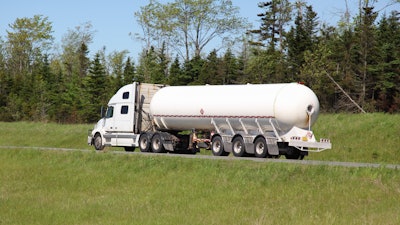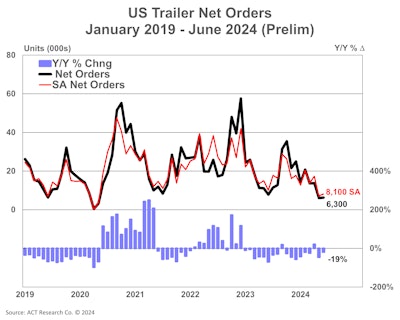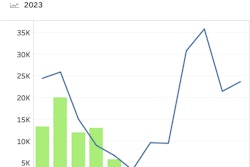
The trailer industry had a tricky month to track in June, with the market’s two main data firms having opposite analysis of the month’s preliminary order totals.
ACT Research announced Tuesday its preliminary net trailer order total rose slightly from May to June, but at 6,300 units, was lower compared to last June, down 19% year over year. Seasonal adjustment (SA) at this point in the cycle boosts June’s tally to 8,100 units, ACT adds.
Conversely, FTR reported Wednesday U.S. trailer net orders for June at 4,788 units, down 17% from May but up 44% from a June 2023 order level that was the lowest since at least 2013. The company says the number of trailers ordered over the last 12 months now totals 199,600 units.
“This month’s data show 26,000 trailers were ordered in second quarter of 2024, a 14% contraction compared to the same quarter in 2023. June’s net orders bring the year-to-date tally to 74,500, a reduction of 23,900 units, or 24% lower, compared to the first half of last year,” says Jennifer McNealy, director, CV Market Research & Publications at ACT Research. “This year’s slower trailer orders are no surprise given the elevated order velocity of the past few years, and with continuing weak for-hire truck market fundamentals, and already-filled dealer inventories, it looks like trailer demand is likely to remain constrained for some time.
[RELATED: Finalists named for second annual Trailblazer Award]
But she also adds, “That said, it is important to remember that for orders, we are now in the weakest months of the annual cycle, minimally suggesting there is no catalyst for stronger orders before the fall and the OEMs’ opening of their 2025 order books.”
On the other side, FTR states June’s orders were weaker than seasonal expectations and 71% below the monthly average order level for the last 12 months.
Despite the large year over year gain, the company says June 2024’s net order total nearly tied May 2020 for the third lowest level in the data. The company says this decrease was driven mainly by a substantial drop in gross orders, although cancellations as a share of gross orders remained above 30%.Trailer production decreased by 7% month over month and 29% year over year in June, totaling an output of 20,249 units, 21% lower than the average June build level over the past five years.
“The U.S. trailer market faces significant challenges, primarily due to the stagnant truck freight/rate environment. Additional near-term potential factors may limit the total trailer market’s growth potential/recovery, including high dealer inventory levels, elevated pricing on inventoried units, and falling used trailer values,” says Dan Moyer, FTR senior analyst, commercial vehicles. “The opening of 2025 order books later this year along with the beginning of a potential truck freight recovery may improve market conditions. Meanwhile, OEMs will need to manage production cautiously.”
[RELATED: Who wins on trailer marketshare? And who's gaining ground?]
McNealy says ACT Research does see fleets starting to make more money later this year, “thereby increasing their ability to purchase equipment, the impact likely will be muted for the trailer industry, as we continue to expect their willingness to spend will lean toward the purchase of new power units ahead of the EPA’s implementation of 2027 regulations, which we believe has already begun.”
She adds, “Industry anecdotes suggest that the ‘pause button’ is expected to remain pressed through the remainder of 2024. The industry’s largest segments remain under pressure, cancellations remain elevated as dealers and fleets recalibrate their needs, and external forces like the U.S. presidential election, low used equipment prices, and high interest rates add to uncertainly into the near- and medium-term.”
FTR adds with net orders coming in substantially below production levels, backlogs in June dropped, falling by 15,526 units to end at slightly more than 113,000 units. The larger month over month decrease in backlogs than in production resulted in a decrease of the backlog-to-build ratio to 5.6 months. This ratio is the second lowest level since 2020 and is slightly below the historical average prior to 2020. The current ratio indicates little overall incentive for trailer manufacturers to adjust production levels, the company adds.













